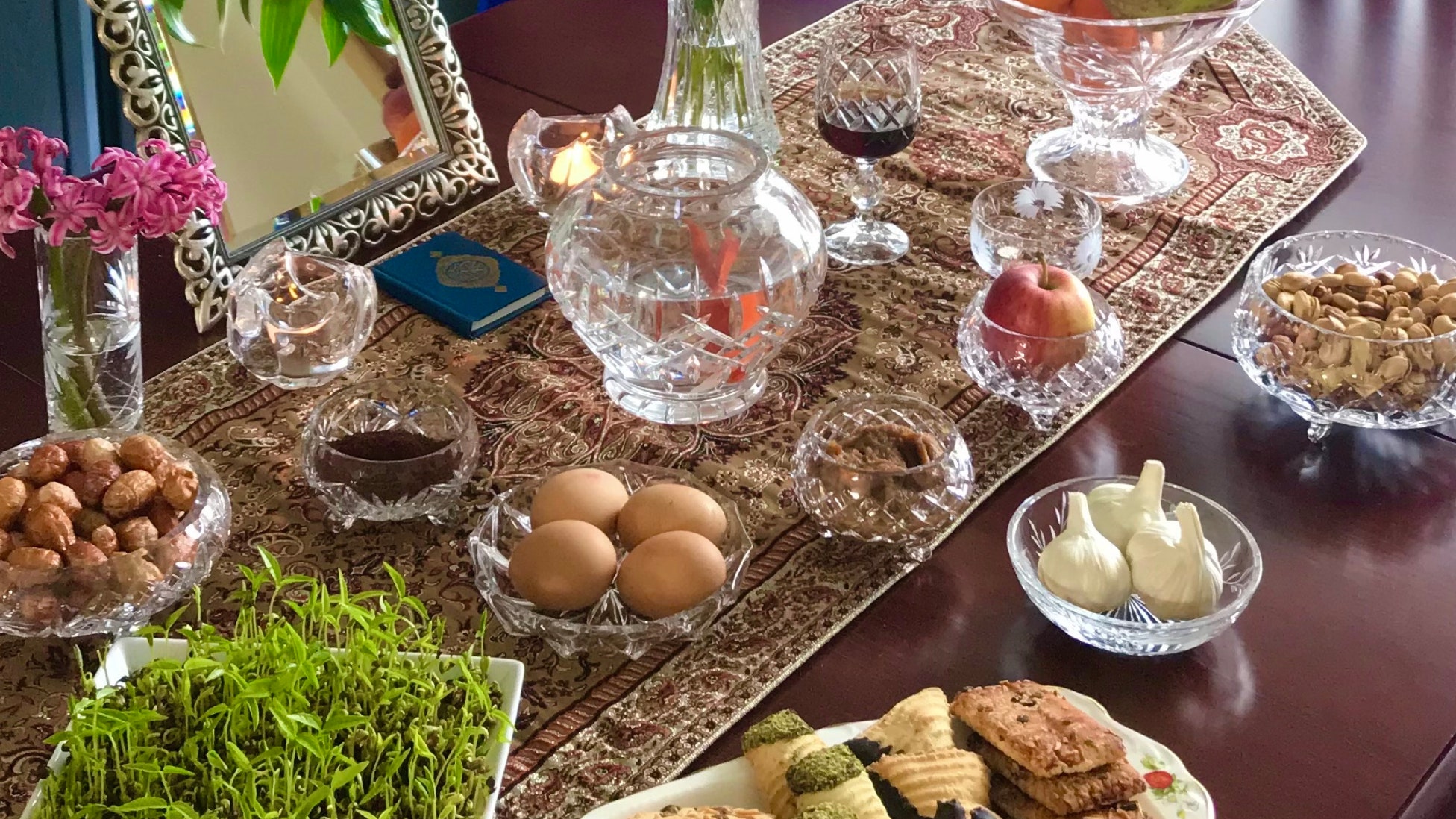Every year, as March arrives, a transformation takes place. The shift from winter to spring brings about a profound sense of renewal and revitalisation, both in the natural world and within oneself. The air becomes fresher, the sun warmer and the mind clearer. These sensations are amplified when I return to my family home in Manchester and am greeted with the delicate aroma of blooming hyacinths, a plate of sabzeh – lentil sprouts – grown on the kitchen windowsill, and the occasional plink of water as a new goldfish stirs in a bowl. These things mean one thing: Nowruz is nigh.
Originating over 3,000 years ago, and rooted in the ancient Persian religion of Zoroastrianism, Nowruz celebrates the rebirth of nature and the triumph of light over darkness through a series of symbolic rituals. Observed annually on the vernal equinox, it marks the beginning of a new year for millions of people across Iran, Central Asia and beyond. It ushers in the possibility of a fresh start: a ‘now-ruz’ – a ‘new day’.
‘Nowruz is a time for unity. It emphasises the importance of family and community, and of the resilience and hope that lies at the heart of the human spirit,’ says Leila Nazarian, the creative visionary behind Eclectic Decks, an art and lifestyle brand based in Santa Monica. Established in the cradle of skate culture, her brand sees traditional Iranian art and craftsmanship translated on to skateboard decks, marrying her cultural connections to both Iran and America. From her time living in Kerman, Iran, she recalls how, in the run up to the new year: ‘Neighbourhoods are packed with merchants selling herbs and goldfish. Flowers are blooming and trucks are loaded with bundled Persian rugs that are being sent for washing.’
Persian rugs being beaten and rinsed, floors being scrubbed and windows being cleaned to sparkle are where preparations for the festival really begin. It’s called khaneh tekooni, which translates as ‘shaking the house’. My Iranian mother takes this chance to venture into the next year unblemished very seriously. Believing that bad omens thrive in the dark, dirty corners of a house, we prepare our homes to welcome in a new year rid of cheshm (evil eye). But the process of purification goes deeper than this.
Paria Farzaneh is a designer who embodies a combination of artistic flair, emotional depth and intelligent design sensibility. Her creations showcase a singular blend of traditional Iranian craftsmanship and contemporary Western styles, reflecting a deep appreciation for her cultural heritage and willingness to experiment and innovate with new techniques and materials. As we talk about Nowruz, she tells me that the tradition ‘marks a fresh start … As a child, I didn’t fully appreciate the importance of this practice, but now I understand its significance. It's a reminder to shed old habits and beliefs and move forward into adulthood with a clean slate.’
Chaharshanbe Suri, the Iranian Festival of Fire, falls on the Tuesday preceding Nowruz. People gather and celebrate the triumph of light over darkness, good over evil and hope over despair. On this night, people light bonfires and jump over the flames, singing songs and reciting poems: ‘Sorkhiye-to az man, zardiye-man az to’ (‘Let your ruddiness be mine, my sickly pallor yours’).
‘Even if it means having a fire in the back garden, and the neighbours questioning what we’re doing, we’re going to jump over the flames,’ Paria says. ‘Tradition is tradition, and to partake in a custom that has endured over centuries is a testament to the enduring strength and beauty of Iranian culture.’
Once the home has been prepared, we set the sofreh haft-sin. This is a symbolic arrangement of seven items that start with the letter ‘S’ in Farsi. Sabzeh (wheat or lentil sprouts) for rebirth and growth; samanu (a sweet pudding made from wheat germ) for sweetness and fertility; senjed (dried oleaster fruit) for love; seer (garlic) for medicine; seeb (apple) for beauty and health; sumac for new beginnings and the sunrise; and serkeh (vinegar) for age and patience.
In true Persian style, individuals are free to practise artistic licence when arranging their haft-sin. My mother opts for paisley-patterned tablecloths, called termeh, or kalamkari fabrics. Leila describes the origin of her dishes, which were custom-made for the occasion: ‘When I was in Isfahan meeting the Qalamzani artisan who produces the metalwork for Eclectic Decks, I asked if he could create a few small plates for me to use for my haft-sin. When I look at them, they rouse memories of roaming around the bazaar at Naqsh-e Jahan square, and drinking tea while lounging on the grass.’
‘I’ve been having so many ideas of how I’m going to present my haft-sin this year,’ Paria says. ‘I’m an artist, and I’m thinking about it in an immersive way, whereas my mum’s doing it in her style. Everyone has their own interpretations, thinking about what table it’ll be prepared on, what bowls they’ll use, if they want to use termeh…’
Instagram content
This content can also be viewed on the site it originates from.
As we spring-clean our houses, jump over fires and lay down the sofreh haft-sin, we reflect on the bygone year, and for 13 days the haft-sin becomes a little shrine. On the 13th day after the turning of the year, we celebrate Sizda Bedar – a day when families immerse themselves in nature, sending the sabzeh from their haft-sin down the river, symbolising its return to nature. This year, in particular, Iranians observe Nowruz with heavy hearts as we mourn the loss of those who aren’t here to ring in the new year with us, but also celebrate with arms outstretched, venturing forwards with even more fiery determination as we fight for ‘Zan, Zendegi, Azadi’ – ‘Woman, Life, Freedom’. When we send our sabzeh down the river, we do so with the belief that one day good will triumph over evil; light will prevail over darkness. This is what it means to be Iranian.

